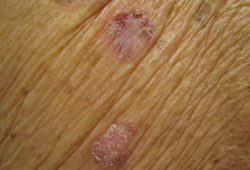Summary
Definition
History and exam
Key diagnostic factors
- single or multiple scaly macules or plaques
- scaly lesions with a hyperkeratotic surface
- well-defined, scaly, brown lesions
- lesions resembling seborrheic keratosis, melanocytic nevus, and early malignant melanoma
- hypertrophic conical-shaped protuberances growing from the surface of the skin
- scaly red roughness with induration, fissuring, and ulceration of the lower lip and the vermilion border
- lesion on sun-exposed area of body
- skin-colored, papillomatous, elevated wartlike papules
- plaques with very mild scale over very thin shiny skin
- violaceous well-defined papules with fine white lines on the surface
Other diagnostic factors
- evidence of sun damage to skin
- pruritus or bleeding
Risk factors
- chronic exposure to UVB radiation
- light-colored skin, freckling, and albinism
- age >40 years
- male sex
- immunocompromise
- xeroderma pigmentosum
Diagnostic tests
Tests to consider
- dermoscopy
- skin biopsy
Treatment algorithm
confluent scalp lesions
head and face lesions, excluding periorbital, actinic cheilitis, and confluent scalp lesions
periorbital
actinic cheilitis
back of hands
below the knee
Contributors
Authors
Brian Berman, MD, PhD

Professor Emeritus of Dermatology and Cutaneous Surgery
University of Miami Miller School of Medicine
Miami
Skin & Cancer Associates, LLP
Co-Director
Center for Clinical and Cosmetic Research
Aventura
FL
Disclosures
BB is, or has been, a paid consultant/advisor for Almirall (manufacturer of tirbanibulin), Lemonex, Berg/BPGBio Pharma, Novartis, Aiviva, Ferndale, Sensus, Novan, Pierre Fabre (manufacturer of 5-FU), Biofrontera (manufacturer of ALA), SUN (manufacturer of ALA), LEO (manufacturer of ingenol mebutate - removed from market), Sirnaomics, Menlo, Sonoma, PHD Biosciences, Birch BioMed, Mediwound, Mino Labs, and Thirona. He has been a speaker for Almirall (manufacturer of tirbanibulin), LEO (manufacturer of ingenol mebutate), and Sensus. His institution has received investigator funding from Biofrontera (manufacturer of ALA), LEO (manufacturer of ingenol mebutate), Pulse, Sirnaomics, Menlo, Birch BioMed, and Mediwound. BB has stock options in Thirona and Mino Labs.
Sadegh Amini, MD

Dermatologist
Skin and Cancer Associates
Voluntary Assistant Professor
Department of Dermatology and Cutaneous Surgery
University of Miami
Miller School of Medicine
Miami
FL
Disclosures
SA has been compensated by Primus Pharmaceuticals, Inc. for being a member of the clinical advisory board.
Peer reviewers
David S. Cassarino, MD, PhD
Assistant Professor
Departments of Pathology and Dermatology
UCLA
Los Angeles
CA
Disclosures
DSC declares that he has no competing interests.
Christopher Shea, MD
Dermatopathology Fellowship Director
University of Chicago
Section of Dermatology
Chicago
IL
Disclosures
CS declares that he has no competing interests.
Peer reviewer acknowledgements
BMJ Best Practice topics are updated on a rolling basis in line with developments in evidence and guidance. The peer reviewers listed here have reviewed the content at least once during the history of the topic.
Disclosures
Peer reviewer affiliations and disclosures pertain to the time of the review.
References
Key articles
Berman B, Bienstock L, Kuritzky L, et al. Primary Care Education Consortium; Texas Academy of Family Physicians. Actinic keratoses: sequelae and treatments. Recommendations from a consensus panel. J Fam Pract. 2006 May;55(5):suppl 1-8. Abstract
de Berker D, McGregor JM, Mohd Mustapa MF, et al. British Association of Dermatologists' guidelines for the care of patients with actinic keratosis 2017. Br J Dermatol. 2017 Jan;176(1):20-43. Abstract
Eisen DB, Asgari MM, Bennett DD, et al. Guidelines of care for the management of actinic keratosis. J Am Acad Dermatol. 2021 Oct;85(4):e209-33.Full text Abstract
European Dermatology Forum. Evidence and consensus based (S3) guidelines for the treatment of actinic keratosis. 2015 [internet publication].Full text
Eisen DB, Dellavalle RP, Frazer-Green L, et al. Focused update: guidelines of care for the management of actinic keratosis. J Am Acad Dermatol. 2022 Aug;87(2):373-4.e5.Full text Abstract
Reference articles
A full list of sources referenced in this topic is available to users with access to all of BMJ Best Practice.

Differentials
- Squamous cell carcinoma (SCC) in situ (Bowen disease)
- Invasive SCC
- Keratoacanthoma
More DifferentialsGuidelines
- Focused update: guidelines of care for the management of actinic keratosis
- Guidelines of care for the management of actinic keratosis
More GuidelinesLog in or subscribe to access all of BMJ Best Practice
Use of this content is subject to our disclaimer